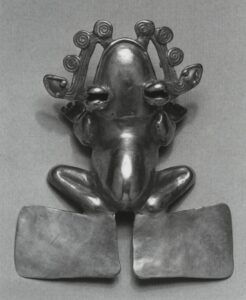A kid who was convicted of grand theft for taking jewelry is under court order to apologize – even though he says he’s not sorry, because he didn’t do it. It has been ruled that his apology need not be an admission of guilt, so he has to go ahead and apologize. Yes, anyway. In writing.
The kid, referred to by California’s First Appellate District court as JC, had been hired by one of his high school teachers (referred to by me as Ms T), to do chores at her house during school holidays. No complaints. He was helping Ms T get her classroom ready for the school year when she noticed he was wearing a striking pendant on a chain. A custom-made pendant, worth, say, $3-4,000. Her custom-made pendant, which she had thought was in a secret jewelry box in her house.

Maybe it was like this Spanish-Polish eagle pendant. You’d only wear a pendant like this on special occasions, I feel.
“Where the frack did you get that pendant?” she inquired, more or less. JC explained (it’s not clear in what order) that a friend gave him the pendant, that he didn’t remember where it came from, and that he had found it when vacuuming behind the couch in Ms T’s house, put it in his shorts pocket to give to her, forgotten it was there, months later went to put the shorts on again, found the pendant, and put it around his neck to keep it safe until he returned to her – here you are, Ms T!
She didn’t think so. She called the cops.
In court JC stuck to the story about finding the pendant while vacuuming and planning to turn it over, The court didn’t believe it. (Vacuuming behind a couch? Come on.) He got three years probation, with some conditions, including that he write an apology to Ms T of at least 50 words.

Panamanian pendant showing frog biting two-headed snake. It’s in the Walters Art Museum, so I’m pretty sure I’d have to get another one custom-made if I wanted one. Which I absolutely do.
JC appealed, arguing that to apologize would be to admit to stealing the pendant, which he insisted he did not do. Therefore the apology would violate his right against self-incrimination under the state and federal constitutions.
The appellate court dug right in. “Appellant’s contention rests on the assertion that a ‘letter of apology necessarily had to express remorse for some wrongful act, thus entailing an admission of guilt.’ We disagree.”
The court looked up “apology” in the American Heritage dictionary. One of the three definitions given is “An acknowledgement expressing regret, or asking pardon for a fault or offense….” Thus, “While an admission of guilt of a crime may be a form of apology, it is not necessarily the only way appellant can express regret for what happened to the victim, or by which he might offer a justification, explanation or excuse for his own complicity in the victim’s loss.”
So the appeals court upheld the trial court – by giving JC permission to submit a bad apology.
“I regret that you had the shock of seeing your special pendant on someone else’s neck, and of thinking that someone you trusted had robbed you. That must have been unpleasant! I’m sorry that happened to you, so I’m glad that it was just a total misunderstanding. There, that’s fifty.”
I doubt that’s what the trial court had in mind.
It would be nice to know what really happened, both in JC’s mind and in the real world. The variety of excuses he came up with before he settled on “found it while vacuuming” do not inspire confidence. But they don’t actually prove he’s lying. And if he deliberately stole the pendant, wearing it to Ms T’s classroom seems like a mistake. It’s a mystery.
It would also be nice to know what the fracking pendant looks like.


this story is nutballs.
‘snot nutballs.
It’s a kid. He’s lying.
Plus, I believe it’s the way officers of the court think, tricky bastids. Detective says, “look, you’re not under arrest or anything, but Mr C would simply really appreciate it if you apologize for taking his checkbook. In writing.”
Good sorrywatch column, though.
Oh, I too think he’s lying. But to tell him, “Oh, you have to say you’re sorry but that doesn’t mean you did it or that you actually ARE sorry” utterly demeans the notion of apology. It turns an apology into meaningless words — without any acknowledgment of culpability, remorse, regret, a pledge to change. And the fact that we already have too much crap apologizing is why we started this blog in the first place.
Good thing it’s 2013, and not 1513. Then, they’d have cut off his thieving little hands…
There’s the issue of whether he’s innocent, which is separate from the issue of being forced to write an apology if you’re innocent. (I should have done a better job of separating these issues in the original post.)
Yeah, the smart money says he’s lying. But the smart money can be wrong, shifty kids don’t always lie, and fishy stories are sometimes true. There’s a classic story of a kid who turns in a suspiciously good writing assignment and is wrongly accused of plagiarism or of having had someone else write it — when in fact the kid did write it. It’s a classic because it’s so counterproductive and because it’s happened so many many times.
I don’t think this would happen in adult court. Adults wouldn’t be ordered to write an apology even though they maintained their innocence.
Under the appellate ruling, all he has to do is to express regret (that it happened at all), and Snarly’s right. It does debase the meaning of apology.